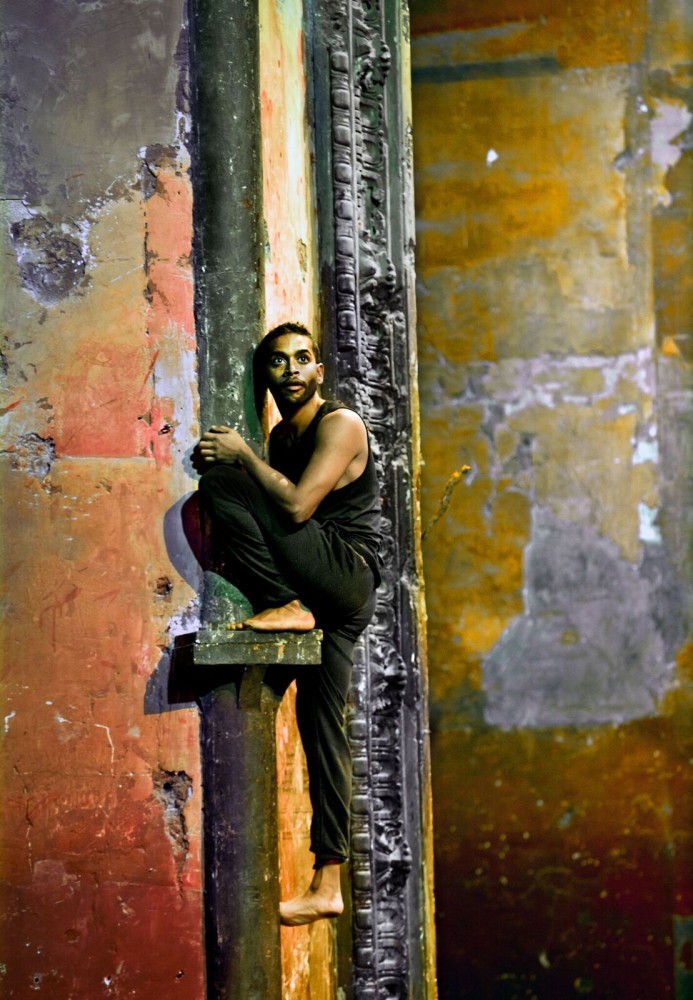by Carol Rocamora
The Sound of Silence.
Storytelling is an ancient art, as old as time, and Peter Brook is its undisputed master on the world stage today.
This legendary British-born director (now 93) and his long-time collaborator, Marie- Hélène Estienne, are once again making magic on the stage of Theatre for a New Audience, this time with a spellbinding story called The Prisoner. It’s a tale that Brook heard about a man in Afghanistan who was condemned to 20 years in prison for an unspeakable crime he had committed. But the leader of his sect devised an alternate punishment for the prisoner – to spend the entire sentence outside the prison, rather than within, on a hillside facing it. In that way, according to Brook’s interpretation, he could face the prison within himself.
It’s a fascinating parable, and Brook and Estienne have brought it to remarkable life on the TFANA stage, using the unique theatrical craft that Brook has developed over seven decades. Its distinguishing features – economy, simplicity, clarity – are the formula for uncovering universal truths in all the stories Brook tells. There’s the “empty space” (title of Brook’s most famous book). There are the primitive elements – sticks and stones and sawdust, light and dark, fire and water (set elements by David Violi, lighting by Philippe Vialatte), and sounds of nature. There is the elegant direction and the spare dialogue (by Brook and Estienne in collaboration.) And there’s the ensemble of actors representing a multiplicity of nationalities (Sri Lanka, France, Mali, Mexico, India, Britain). Combined, these essential elements are the signature style of this masterful theatre artist whose productions and books have defined contemporary world theatre.
The Prisoner is stunning in its simplicity and universality. It’s told by a narrator (Hayley Carmichael), who introduces the prisoner Mavuso (Hiran Abeysekera) just before his legs are broken by his accuser with a stick. The scene is brutal, made even more vivid by the spare, symbolic direction. That stick, along with others, will soon define the cell in which Mavuso is temporarily incarcerated, until he is led out onto the hillside where he will serve his sentence gazing at the prison.
Each ensuing encounter – between Mavuso and his beloved sister, Nadya (Kalieaswari Srinivasan), then his uncle (Hervé Goffings), then his guard (Omar Silva) – is intense and impassioned, but it is when the prisoner is alone onstage, sitting on that hillside in silence, that the true drama is revealed. And that is the drama within, as the prisoner lives out his sentence and faces his punishment – self-judgment and atonement.
An unexpected, wonderfully humorous moment comes when the prisoner discovers a rat. Abeysekera’s puppeting skills at creating and manipulating the creature are both masterful and delightful – until the rat “bites” him and the scene turns ugly and violent. Indeed, this story is filled with the darkest crimes that man can commit, including murder and incest – crimes for which the prisoner must suffer. “To pay, you have to free yourself,” his uncle tells him.
Brook’s profound understanding of Dostoevsky and Beckett – both of whose work he has directed – informs The Prisoner. Though the place is never specified (it could be anywhere), the landscape of Beckett’s Waiting for Godot is conjured up before our eyes. In this case, however, the “waiting” is not for a savior, but rather for enlightenment within. A man sitting alone in silence, facing the audience and the prison beyond, is one of the most profound images of the quest for self-knowledge that we’ll ever see on stage. It’s like Hamlet, alone on stage in his seven soliloquies – only in the case of Brook/Estienne and their prisoner, it’s the sound of silence that resonates louder than words.
Photos: Simon Annand & Joan Marcus
The Prisoner, written and directed by Peter Brook and Marie-Hélène Estienne, at the Theatre for a New Audience, Polonsky Shakespeare Center, through December 16


























